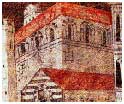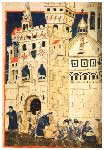FRANCESCO DI MARCO DATINI/3
76 Kb.

In forming these warehouses, Datini adopted an identical procedure; he sent one of his collaborators to the place to begin operations, supported by a corresponding company. The firm was then constituted at a later date, entrusting it to the same collaborator or to a steward taken from his company, and, bit by bit, he was promoted to directorship and ultimately partnership.
31 Kb.

So it was for the company in Florence, set up by Stoldo di Lorenzo and directed by him for seven years, to be followed by Luca del Sera. So it was also for the company at Pisa, brough to life by Manno d'Albizzo. The same happened with the company at Genoa which saw the light in 1392 and which Luca del Sera was originally called to manage, followed by Andrea di Bonanno. Again Luca del Sera concerned himself in 1393 with the opening of a warehouse in Catalonia, then to become an autonomous company - the last of the merchant series in 1396.
67 Kb.

Meanwhile, Francesco had entrusted a domestic, non-trading concern with his affairs in his home-city. Responsible for this from 1384 to 1390 was Monte di Andrea di Ser Gino of the noble Prato family Angiolini. After an interregnum of two years following his death, with Simone d'Andrea Bellandi expressly summoned from Pisa, Barzalone di Spedaliere took over. The latter also pursued the affairs of the company organisms in Prato and he was also afforded the task of executor of his will.
61 Kb.

Backing him up in his work we often find reference to Niccolò di Piero di Giunta del Rosso, woollen draper and Datini's partner - in person or via his children - in a "quote Company of the Wool Guild", of which a perfect, almost integral accounting documentation has remained, and the Company of Dyers.
In November 1398, the company of Banco saw the light, in partnership with Domenico di Cambio. At that time, the Datini company system reached its greatest extension.
In November 1398, the company of Banco saw the light, in partnership with Domenico di Cambio. At that time, the Datini company system reached its greatest extension.
68 Kb.

Though Prato was the natural seat of the domestic, non-trading
concern, in actual fact Francesco resided there only in a discontinuous
fashion. He had begun to move around already immediately after
his return. He went to manage the company set up in Pisa personally
and frequently resided in Florence where he had first taken lodging
near the Ponte alla Carraia, then in Porta Rossa and in Por Santa
Maria, when he enrolled in the guild which this road was named
after. Later on, he chose Via Santa Cecilia and Piazza Tornaquinci.
22 Kb.

He moved to Florence completely in 1394 to escape the increased
weight of district taxes, applying for citizenship which was
granted to him the same year.
Meanwhile, his main abode in Prato was getting bigger and more opulent and he had bought and sorted out the Palco villa.
Meanwhile, his main abode in Prato was getting bigger and more opulent and he had bought and sorted out the Palco villa.